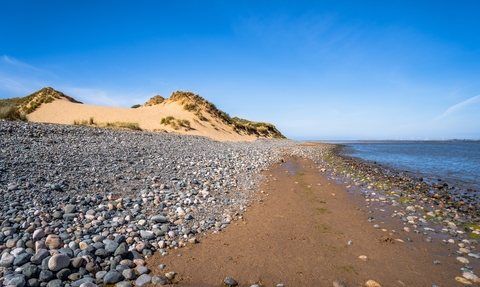
Sandscale Haws Nature Reserve © Michelle Crake
Save Sandscale Haws' wildlife from development
New resort will devastate wildlife
The public consultation for a 450-lodge holiday resort at Roanhead near Barrow-in-Furness is now closed.
The proposed resort would be on agricultural land next to Sandscale Haws, a national nature reserve and part of the Duddon Estuary Site of Special Scientific Interest.
The closeness of the resort to this sensitive dune habitat will be disastrous for an important population of rare natterjack toads as well as other threatened wildlife like otters, wading birds, precious plants and the rare spring mining bee.
Natterjack toads
The nature reserve is home to a quarter of the UK’s population of this rare amphibian, which is only found at a handful of sites around the country. Cumbria has over half their breeding sites, and Sandscale Haws is a stronghold, with over 40 breeding pools.
Other special wildlife
Sandscale Haws is an IPA (Important Plant Area) which means it’s a key site for exceptional botanical richness including rare wildflowers like coralroot orchid, yellow bird’s-nest and dune helleborine. It’s also home to several species of bat and owls. There are over 300 species of fungi found here.
Wildlife disturbance
Right now Sandscale Haws National Nature Reserve has 100-200 visitors a day. This new 450-lodge development could increase visitors by 173%.
Roanhead has some of the darkest skies in Cumbria. The light and disturbance from the large-scale resort, which could host 1,000-2,000 people at any one time, will have a negative effect on nocturnal natterjack toads.
Over 70 species of fungi recorded on Sandscale Haws are on the English Red Data list of threatened species.
Why is Sandscale Haws National Nature Reserve important?
Sandscale Haws, which is managed by the National Trust, is an outstanding dune habitat on the Duddon Estuary. The beach is home to numerous rare plants, butterflies and wildflowers along with an estimated 25% of the UK's natterjack toad population. It hosts a complete range of other British amphibians, including smooth, palmate and great crested newts and common lizards. Look for herons and little egrets feeding from the dune slack pools.
Clouds of common blue butterflies feed here, as does the dingy skipper; silvery grayling, wall brown and dark green fritillary flit silently through the sandhills throughout the summer. Dragonflies, such as the emperor and four-spotted chaser, hunt among the ponds and marshes.
Over 600 plant species have been recorded across this 700-acre reserve. In the dune slacks, grass of parnassus and round-leaved wintergreen shine white; while bee, northern marsh and coralroot orchids are dune specialists. Low-growing sea holly is common here, and delicate dune pansy glows purple across the area.
Throughout the year, the mudflats and sandbanks offer a banquet for birds, including ringed plovers, terns, turnstones and oystercatchers, skylarks, whitethroats and pipits. Raptors include peregrines, buzzards and hen harriers. The winter months are the best time to see birds in big numbers, with 70,000 knots, redshanks and dunlins feeding amid small flocks of sanderlings.
Please tell Westmorland and Furness Council about these amazing and rare plants and animals.
Where can I see the holiday resort plans?
Full details of the proposal are available on the developer’s website.
View all the planning application documents on the local council planning hub website. The planning application reference is B06/2023/0307. The relevant document is: Environmental Statement - Chapter 6 Biodiversity (SHF.290.001.PL.R.100.00) (2) 09-06-23
Why is this the wrong location for the holiday resort?
The holiday resort will be located very close to Sandscale Hawes Nature Reserve and it's this proximity that we object to. It’s estimated that 1,200 guests could be at the resort at any one time and this will cause light and disturbance, both of which will have negative impacts on a nationally significant habitat for natterjack toads, along with increased road traffic.
As many guests are likely to bring dogs, this could negatively affect ground-nesting birds on the beach front, in particular during nesting season (April to August). Wider repercussions could include additional strain on the main sewage network in Barrow and the impact this may have on important seagrass meadows in the area.
Please ask Westmorland and Furness Council not to locate the holiday resort at Roanhead.
Why do we care about natterjack toads?
Natterjack toads are a rare and protected species - it’s illegal to disturb or handle them without a license.
They are in decline, and beyond the north-west and Solway coasts, they cling on at just a handful of dunes in East Anglia and on sandy heaths in Surrey and Hampshire. Cumbria boasts over half the UK’s natterjack breeding sites, from Barrow-in-Furness up to the Solway Firth. They’re found in upper salt marsh areas, above the strand line and in sand dunes.
Natterjack toads are found in sandy habitats on our coastal areas, where they breed in shallow pools. To find shelter, the toad burrows into the sand, using its forelimbs to dig, pushing debris behind it like a dog as it tunnels into the sand, sometimes up to 60cm deep. The toad will shelter there, often alongside others, before emerging at night to feed on moths, woodlice and other insects.
In springtime, after dark, up to several hundred males sing in chorus to attract mates – it’s an amazing and unforgettable sound which can be heard up to a mile away!
Natterjack toad numbers are in decline because of habitat loss – healthy sand dunes are one of the most threatened environments in Europe for biodiversity loss. Cumbria Wildlife Trust is working closely with partners to repair and restore important sand dune habitats in Cumbria.
Please tell Westmorland and Furness Council how important this habitat is for these rare and protected toads.



